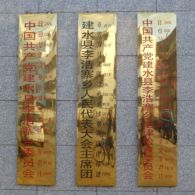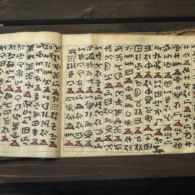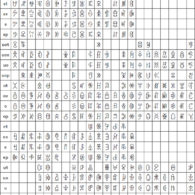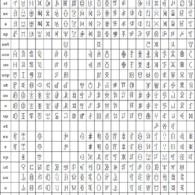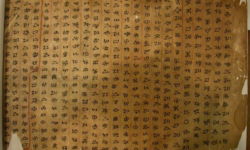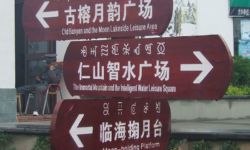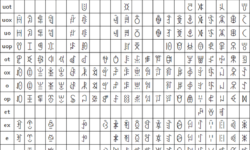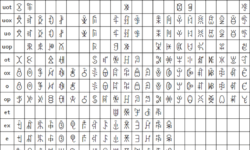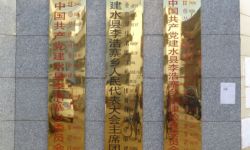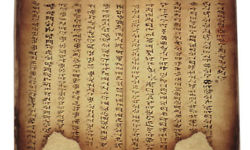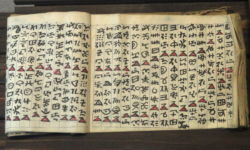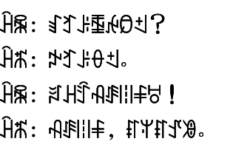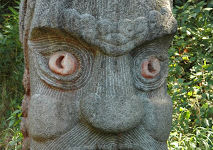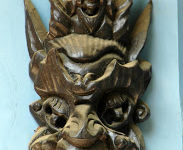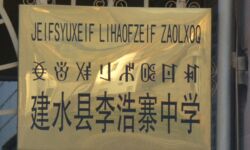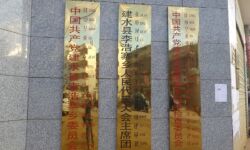Profile
Yi is perhaps the most elastic writing system in the world.
The Yi are a minority nationality of China, some 7–8 million in number, who – until 1,500 years ago – had their own dynastic homeland in southwest China around Kunming, but were defeated and dispersed around the region, with small numbers settling in Vietnam and Laos.
With diaspora comes fragmentation, and with fragmentation come linguistic variation and language loss: of the sixty or more languages that now comprise the Yi language family, most are endangered and some are in the process of disappearing. This process has accelerated since 1950, thanks to the official Chinese process of trying to “standardize” indigenous and minority languages and scripts.
Even without this external influence, though, the Yi script always had its own reasons for, and means of, varying.
Originally, written Yi, which might better be called the Yi script family, was ideographic, and existed as several overlapping but distinct regional scripts: Nosu, Nisu, Nasu and Sani.
The Yi are animists, with elements of Taoism, shamanism and fetishism. Shamans/medicine men are known as bimo or pimu. Bimo officiate at births, funerals and weddings. They are often seen in the street consulting ancient scripts. As animists, Yi worship the spirits of ancestors, hills, trees, rocks, water, earth, sky, wind and forests. Magic plays a major role in daily life through healing, exorcism, asking for rain, cursing enemies, blessing, divination and analysis of one’s relationship with the spirits. They believe dragons protect villages against bad spirits, and demons cause diseases. After someone dies, they sacrifice a pig or sheep at the doorway to maintain a relationship with the deceased spirit.
Writing was, and is, central to this world view, used almost exclusively by bimo for life-cycle, divination and healing rituals, keeping historical and genealogical records. Books were handwritten on handmade paper, bound into books with handmade hemp covers, and rolled up for storage. Traditionally, each shaman would train a son or nephew to succeed him, a process that involved copying all his mentor’s books, plus as many other books as he could find. (All literate shamans were men; female religious-healing practitioners did not use writing.)
The word “copy” should not imply that each manuscript was identical to its original, however. The representation of one word by a single character is a modern innovation, based on the Chinese governmental desire for standardization. In traditional materials, a single word or idea might be written in many different ways. The most extreme example is the character meaning “not” in Nisu, of which no fewer than 103 different versions have been found. One shaman used twenty-two alternative forms in a single text, possibly as a series of stylistic flourishes, possibly as a means of disguise.
With such latitude for individual expression, it’s hardly surprising that over time the collective written Yi vocabulary became larger and larger. Originally the Yi script family is said to have consisted of 1,840 characters, but there are now as many as 90,000 recorded glyphs, including some forty different ways of writing the word “stomach.”
The various members of the Yi written family even use different kinds of punctuation. Nisu and Nasu manuscripts insert a comma equivalent to indicate pauses in chanting. The Nisu version is an equilateral triangle resting on one base, often coloured red, with a horizontal line going to the left from the top. The Nasu “comma” is a small circle at the bottom right or left of the last character in the chanted line.
Yi even refused to be restrained by geometry. At first – perhaps 1,400 years ago – all the Yi variants were written, like Chinese, from top to bottom and right to left. At some point, though, the Nosu version got rotated 90 degrees clockwise, and was read from left to right, starting at the top.
In 1974, the Sichuan government set about to convert and consolidate the Yi scripts into a syllabary, the largest ever to be (to some extent) standardized. All syllabic Yi characters are made from five basic strokes: dot, horizontal line, vertical line, arch and circle. This was combined with the Liangshan dialect of Yi being promoted to becoming the standard variety to be used in government and education throughout the Yi communities of Sichuan.
Yi was not to be so easily reined in, however. Three other provinces – Yunnan, Guizhou and Guangxi – still use the ideographic form of Yi (interestingly, showing the limits of the Chinese policy, whatever the official aims), and other dialects of Yi do not yet have a standardized script. There are 756 basic glyphs based on the Liangshan dialect, plus 63 for syllables only used for words borrowed from Chinese.
Chinese legislation states that standardized Yi is written horizontally, from left to right. The traditional form used in southern Sichuan, however, is still written in vertical columns from top to bottom and right to left, then rotated 90 degrees counterclockwise, so that it is read in horizontal lines from left to right.
Yi would seem like a perfect candidate for imperillment, but Ben Yang reports that in 2019, “Ideographic Yi is a current, living script with modern users and extensive government support.” It’s heartening that this ancient and profoundly nonconformist writing system continues to resist.
You can help support our research, education and advocacy work. Please consider making a donation today.
Links
General Script, Language, and Culture Resources
- Omniglot
- Wikipedia
- Learn Yi Vocabulary Video
- 600 Phrases in the Yi Dialect
- Scriptsource
- People of the Stone Forest Blog Post
- Puzhehei Blog Post
- Video lecture on the practices of the bimo priest/shamans of the Yi people.
- Video introduction to Yi script
- Video introduction to Yi vocabulary
- Lecture in English on Yi script
Community Resources
Font/Keyboard Resources
Gallery
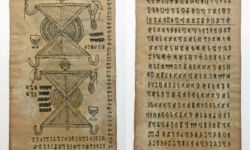
A Nuosu-Yi Bimo manuscript from Yunnan, South-West China, late 19th century. Full page drawings of the founder of the Yi civilisation, Zhyge Alu, with his copper helmet, net bag and bow & arrows. Photo by the Incunabula Group. Please do not reuse without permission.
